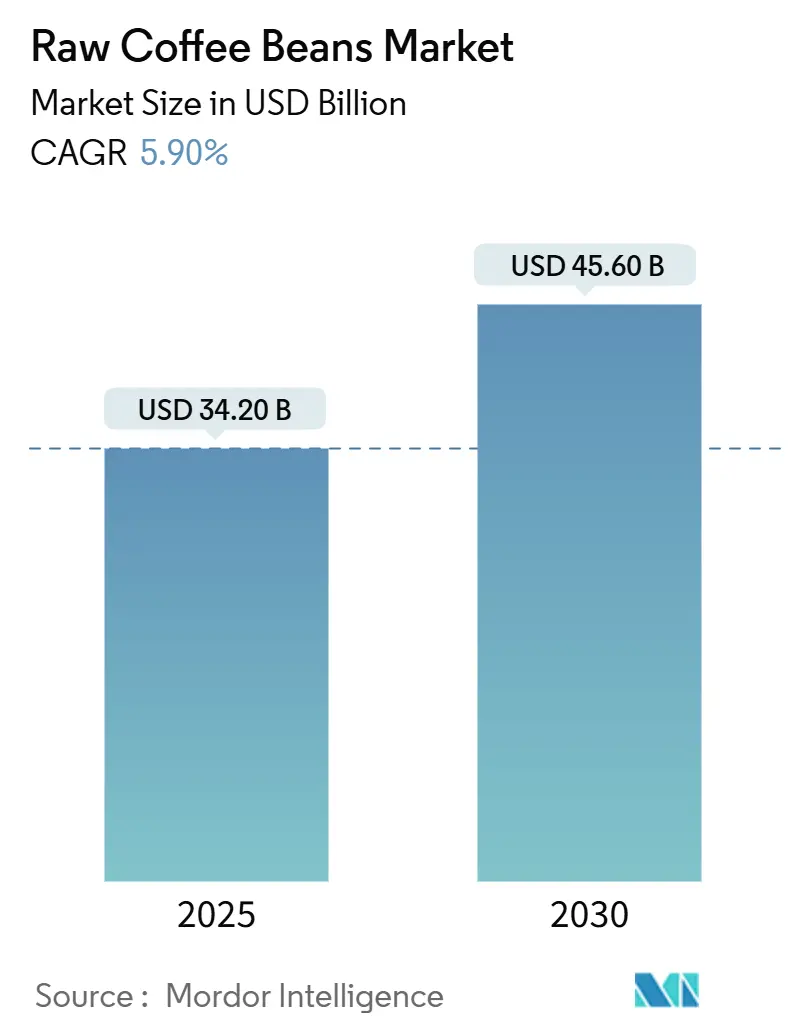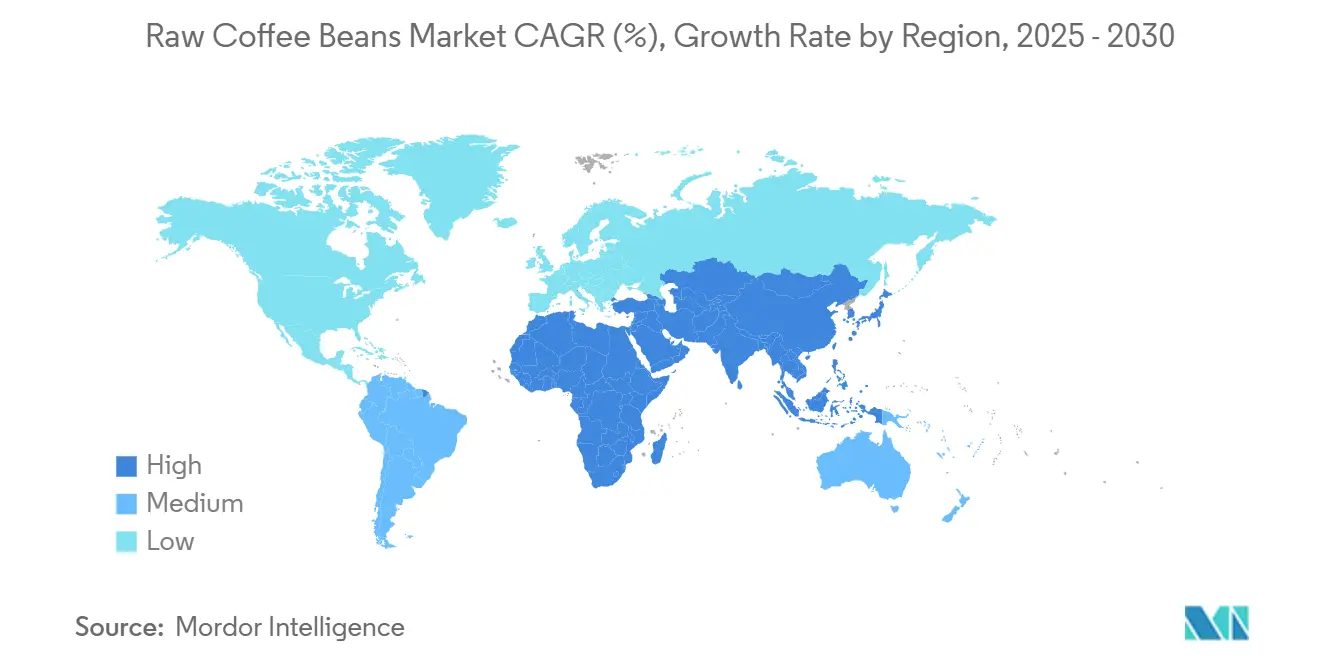Raw Coffee Beans Market Size and Share

Raw Coffee Beans Market Analysis by Mordor Intelligence
The raw coffee beans market size reached USD 34.2 billion in 2025 and is forecast to climb to USD 45.6 billion by 2030, reflecting a 5.9% CAGR over the period. Sustained price momentum of the raw coffee beans, which gained 63.98% during the last 12 months, signals durable demand even as supply chains digest climate shocks and new tariffs. Brazil’s spot price of raw coffee beans surged to R$1,490.14 per 60-kilogram bag (USD 298.0) in 2024, an 80% jump that pushed importers toward early purchasing and diversification. Parallel investments in blockchain traceability now cover 42,000 raw coffee bean farmers across Honduras, India, and Kenya, reshaping how quality premiums reach origin and reducing verification costs for buyers. Corporate net-zero pledges are accelerating sustainable sourcing, with Starbucks rolling out 6,000 greener stores while Nestlé surpasses 30% regenerative-agriculture coverage ahead of its own 2025 target.
Key Report Takeaways
- By production geography, South America held a 43.6% share of the raw coffee beans market in 2024, while Asia-Pacific is expanding at the fastest 7.2% CAGR through 2030.
- By consumption geography, Europe commanded 33.1% of 2024 demand, whereas Asia-Pacific is projected to advance at a 6.5% CAGR to 2030.
- By export geography, South America accounted for 54.8% of global flows in 2024; Asia-Pacific shows the strongest 7.8% CAGR outlook to 2030.
- By import geography, Europe led with 36.2% of inbound volumes in 2024, but Asia-Pacific is growing quickest at 7.1% CAGR to 2030.
Global Raw Coffee Beans Market Trends and Insights
Drivers Impact Analysis
| Driver | (~) % Impact on CAGR Forecast | Geographic Relevance | Impact Timeline |
|---|---|---|---|
| Expanding specialty-coffee culture in emerging markets | +1.5% | Asia-Pacific core, spill-over to the Middle East and Africa | Medium term (2–4 years) |
| Rising certification premiums for sustainable beans | +1.2% | Global, early gains in Europe and North America | Long term (≥ 4 years) |
| Growth in the ready-to-drink coffee manufacturing demand | +0.8% | North America and Asia-Pacific | Short term (≤ 2 years) |
| Digital spot-trading platforms are improving price transparency | +0.7% | Global | Medium term (2–4 years) |
| Corporate net-zero procurement commitments | +0.6% | North America and Europe | Long term (≥ 4 years) |
| Climate-resilient varietal R&D breakthroughs | +0.5% | South America and Africa | Long term (≥ 4 years) |
| Source: Mordor Intelligence | |||
Expanding Specialty-Coffee Culture in Emerging Markets
China now hosts more coffee shops than the United States, opening a premium addressable base of 1.4 billion consumers. Asian buyers favor single-origin and artisanal brews that fetch 15-30% premiums over commodity grades. Saudi Arabia leads global growth as regional shop counts in the Middle East and North Africa jumped 11% in 2024, reaching 11,163 units. Specialty adoption across Asia-Pacific is projected to grow 15.3% annually to 2030, far outpacing instant-coffee formats. As a result, roasters are bypassing traditional channels by entering direct-trade deals, funneling higher margins back to producers willing to meet traceability and sustainability specifications.
Rising Certification Premiums for Sustainable Beans
Fair Trade certification delivers an average USD 0.20-per-pound premium, while organic adds USD 0.30–0.50, materially lifting farmgate income[1]Source: “Coffee Certification Premium Analysis,” Fair Trade USA, fairtrade.org. Nestlé’s regenerative sourcing already covers 30% of strategic raw materials ahead of plan, enlarging demand for verified lots. The EU Deforestation Regulation magnifies this pull by requiring audit-grade forest-mapping proof, a gap that Intercontinental Exchange's (ICE) Commodity Traceability Service now fills with geospatial data. Blockchain pilots in Honduras, India, and Kenya show how digital certificates shrink verification costs and speed premium payouts. Rising compliance costs for uncertified volumes, therefore, widen price differentials and lock in demand for certified beans across European channels.
Growth in Ready-to-Drink Coffee Manufacturing Demand
North America’s ready-to-drink segment is forecast to touch USD 128.10 billion in 2025, catapulting demand for liquid extracts requiring lower-acidity beans that trade 10–15% above standard grades[2]Source: National Coffee Association, “National Coffee Association USA Homepage,” National Coffee Association, ncausa.org. Nestlé’s freeze-drying breakthrough improves cold-coffee solubility, expanding product shelf life. Asia-Pacific demand rides on rapid urbanization and a convenience culture that favors portable formats. Processing innovation now monetizes coffee waste; ofi commercializes cascara powder while PectCof extracts Dutch Gum emulsifiers, creating parallel revenue streams that strengthen overall bean economics.
Digital Spot-Trading Platforms Improving Price Transparency
Blockchain platforms such as GrainChain give 12,000 Honduran farmers direct market visibility, erasing 15–20% intermediary margins. Trade In Space connects producers and roasters via satellite-brokered smart contracts, eliminating exchange fees. India’s Coffee Board supports 30,000 growers on its ledger, standardizing grading and pricing[3]Source: Coffee Board of India, “Coffee Board of India Homepage,” Coffee Board of India, indiacoffee.org. These tools lower hedging costs during price swings and tokenize quality data as tradable assets, adding new income streams.
Restraints Impact Analysis
| Restraint | (~) % Impact on CAGR Forecast | Geographic Relevance | Impact Timeline |
|---|---|---|---|
| Increasing climate volatility in key origins | –0.9% | South America and Africa | Short term (≤ 2 years) |
| Growing competition from alternative caffeinated beverages | –0.6% | North America and Europe | Medium term (2–4 years) |
| Price instability is deterring long-term farmer investment | –0.7% | Global smallholder regions | Medium term (2–4 years) |
| Stricter EU deforestation regulations are raising compliance costs | –0.5% | Global, EU-bound trade | Short term (≤ 2 years) |
| Source: Mordor Intelligence | |||
Increasing Climate Volatility in Key Origins
Brazil’s 2024 frost and drought lifted coffee bean prices to the highest in decades. Vietnam’s robusta also touched half-century highs on severe dryness. More frequent extreme events documented by the International Coffee Organization cut yields by up to 50% in Central America[4]Source: International Coffee Organization, “International Coffee Organization Homepage,” International Coffee Organization, ico.org. Producers must replant resilient varieties and relocate farms to higher altitudes, which ties up capital for as long as seven years before first harvests. Lenders now price climate risk into working-capital lines, raising costs for smallholders and accelerating consolidation.
Growing Competition from Alternative Caffeinated Beverages
Venture-backed startups such as Atomo and Voyage Foods replicate coffee flavors without beans, signaling potential disruption if scale economics improve. Functional energy drinks continue eroding share in convenience channels, aided by stable input costs from synthetic caffeine. Regional innovations like Saudi Arabia’s date-based Milaf Cola cater to local tastes and shift purchase occasions from hot coffee to chilled functional drinks. Cell-cultured coffee prototypes underscore long-term substitution risk, though commercial rollout remains distant.
Geography Analysis
South America remains the production stronghold with 43.6% raw coffee beans market share in 2024 and a projected 4.3% CAGR to 2030. Brazil’s massive export throughput attests to deep water ports, rail links, and a sophisticated futures hedging ecosystem that shelters growers from currency swings. Colombia leverages its reputation for mild arabica to extract premiums that offset smaller harvest volumes. Continent-wide, new United States tariffs compel suppliers to redirect part of their flows toward Asia and the Middle East, smoothing revenue volatility. Climate instability still looms, prompting wide adoption of irrigation and frost-control technologies in Minas Gerais and Espírito Santo.
Asia-Pacific stands out for velocity. Production expansion at 7.2% and consumption growth at 6.5% reflect Vietnam’s journey from bulk robusta to increasingly differentiated offerings. Government grants foster precision farming, while private investors finance dry mills and color sorters that lift cup scores and selling prices. Indonesia rejuvenates older plantations and tests arabica in higher elevations of Sulawesi. China’s domestic cultivation, though modest, nurtures a farm-to-cup narrative appealing to urban consumers. Regional demand underpins stable offtake, insulating growers from currency shocks and Western recessions.
Europe remains the demand anchor with significant share in 2024, posting a modest CAGR through 2030. Mature but premium-seeking consumers pay more for ethically sourced and low-carbon beans. Importers ramp up satellite verification and blockchain documentation to comply with deforestation rules that take effect by the year-end 2025. Germany and Italy refine roasting techniques for lighter flavor profiles favored by younger drinkers. The region’s tightening sustainability criteria incentivize origin countries to adopt certification schemes and digital traceability sooner than laggards, ultimately reshaping global trade flows toward verifiable supply.

Recent Industry Developments
- August 2025: The United States imposed 50% tariffs on Brazilian coffee and 40% tariffs on Colombian and Vietnamese beans, prompting importers to accelerate shipments and reassess sourcing mixes.
- August 2024: ICE launched its Commodity Traceability Service with Space Intelligence, delivering geospatial forest-mapping for coffee supply chains ahead of EU deforestation rules.
- November 2023: Saudi Coffee Company, a unit of the Public Investment Fund, has opened its first model farm in Jazan. The one-million-square-meter site acts as a living laboratory for sustainable Coffea arabica cultivation. By 2030, the project plans to plant five million trees and lift the Kingdom’s annual production from 300 tons to 2,500 tons. The program supports Saudi Vision 2030 while following global best-practice farming standards.
Global Raw Coffee Beans Market Report Scope
Raw coffee beans are the seeds of the coffee plant, which are roasted and processed to make coffee powders, granules, and other beverage forms. The raw coffee beans market is segmented by geography into North America, Europe, Asia-Pacific, South America, and the Middle East and Africa. The report offers elaborated production (volume), consumption (value and volume), import (value and volume), export (value and volume), and price trend analysis of the market. The report offers the market size and forecasts in terms of value (USD) and volume (metric tons) for all the above segments.
| North America | United States |
| Mexico | |
| South America | Brazil |
| Colombia | |
| Peru | |
| Europe | Germany |
| Italy | |
| Switzerland | |
| Asia-Pacific | Vietnam |
| Indonesia | |
| India | |
| China | |
| Middle East | Turkey |
| Saudi Arabia | |
| Africa | Ethiopia |
| Uganda |
| By Geography (Production Analysis (Volume), Consumption Analysis (Volume and Value), Import Analysis (Volume and Value), Export Analysis (Volume and Value), and Price Trend Analysis) | North America | United States |
| Mexico | ||
| South America | Brazil | |
| Colombia | ||
| Peru | ||
| Europe | Germany | |
| Italy | ||
| Switzerland | ||
| Asia-Pacific | Vietnam | |
| Indonesia | ||
| India | ||
| China | ||
| Middle East | Turkey | |
| Saudi Arabia | ||
| Africa | Ethiopia | |
| Uganda | ||
Key Questions Answered in the Report
What is the projected global value of the raw coffee beans market in 2030?
The raw coffee beans market is forecast to reach USD 45.6 billion by 2030.
How fast is global coffee output expanding in the Asia-Pacific region?
Asia-Pacific production is projected to rise at a 7.2% CAGR through 2030, driven mainly by Vietnam and Indonesia.
How will the EU Deforestation Regulation affect suppliers?
Exporters shipping to Europe must provide geolocation data and forest-mapping proof, increasing compliance costs but unlocking premiums for verified beans.
Which company currently leads global trade volume in raw coffee beans?
Neumann Kaffee Gruppe tops the field with a 13.4% share of worldwide trade volume.
What impact do U.S. tariffs have on Brazilian coffee?
The 50% duty forces importers to front-load purchases and diversify sourcing, potentially redrawing long-term trade flows away from Brazil.
Page last updated on:

